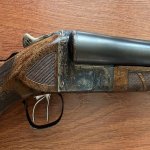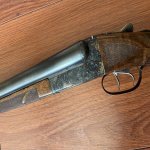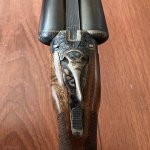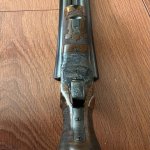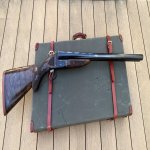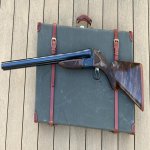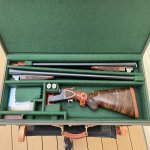You are using an out of date browser. It may not display this or other websites correctly.
You should upgrade or use an alternative browser.
You should upgrade or use an alternative browser.
Let's see some pic's of your SxS's & O/U's
- Thread starter Win/64
- Start date
Londonshooter
CGN frequent flyer
- Location
- SW Ontario
And a real cool guy. Hat's off, Chris. You're the man.
And you two made some great choices, Spank.
And you two made some great choices, Spank.
the spank
CGN Ultra frequent flyer
- Location
- Planet Earth Wearing My Tinfoil Hat
WOW!!! What a shotgun!!! Chris is extremely talented.
I hope that I can see you and this marvelous gun in person when I visit the Wainwright/Lloydminster area at the end of this month.
Bill
I'll be home from a hunting/fishing trip to Northern Ontario Oct 3rd. We will try to get together then Bill.
Looks fantastic!!I received these pictures today. Chris has finished the restoration, reassembled the gun and will take it out this week and test fire it to make sure all is in order before shipping it.
I think he just wants to take it Ptarmigan hunting and I don't blame him.
I'll post clearer detailed pics once I have the gun back but these are good enough to see the beautiful job of rebluing and refinishing of the colour case hardening that was done.
The picture of the beads was to show the new hand turned beads Chris made to replace the old yellowed brittle originals.
The only thing left to do is the gold replating of the triggers. There wasn't time for Chris to find a source and return the gun in time to hunt with this season but at his suggestion I went with having him polish the triggers and leave them as is prepped for later completion. Chris said he may look into doing replating himself in the future and if so he will do them at that time. I'm sure that would be something he could easily accomplish and excel at given the man's talents.
Guns evolve. We don’t see it much today, as the major mechanical advances behind most popular guns today have been around for some time. Just in popular autoloading guns, the gas, inertia and recoil systems have been around for 79, 123 and 125 years respectively. The ‘classic’ double-barreled central-fire hinge-action gun appeared 170 years ago, an advance over the first pin-fire cartridge guns that first saw daylight in France some 190 years in the past. Over/under shotguns are more recent, but have nevertheless been a thing for 114 years now. Inventions, though, never occur in a straight line, as the first central-fire cartridge was developed 215 years ago, and the first hammerless action was designed for it four years later (though shooters did not like giving up their hammers, and it was to be another 60 years before the hammerless idea came back). The only major shotgun advance that has occurred within my lifetime is removable chokes, which have been around for 64 years (though I’ve managed to avoid them so far).
Within these larger developments, there were smaller ones, and there probably wasn’t a single invention or feature big or small that did not meet with opposition. Today’s gun is an example of engineering creativity to increase the speed of loading and re-loading, though it is hard to imagine a time when the shotgun feature of being able to operate an action and close barrels quickly was ‘new,’ and not necessarily appreciated by all. While some viewed the effective use of a breech-loader in a positive light, this opinion was not necessarily shared. James Dalziel Dougall, in his 1857 book Shooting Simplified: A Concise Treatise On Guns And Shooting, did not consider speed desirable:
In the 22 January 1859 issue of the weekly sporting newspaper The Field, one correspondent argued against the breech-loader for its excessive efficiency, with ‘sport’ and ‘fair play’ giving way to ‘slaughter,’ and ‘a murderous day’s work.’ The muzzle-loader, he argued, was enough, the breech-loader being far too deadly. To the proponent of the ‘battue,’ or driven shoot, speed of loading and re-loading was a definite plus, and any means to simplify or quicken the process was advantageous. The appearance of snap-action breech-loaders in 1861-1862 would have been seen by some as essential for a battue, while to others it presaged the death-knell of game numbers. The quickest snap-actions incorporated self half-cocking features, as the rebounding lock was still distant in the future. One such action is that of Joseph Needham of Birmingham, one of several famous inventors with that family name, and whose history is intertwined with that of the breech-loader.
William Needham (b. 1800) and Joseph Needham (b. 1813) of Birmingham were related, though the relationship is not clear. Both were gunmakers. William began his business around 1830, and in 1845 William moved to London where he opened at 26 Piccadilly under the name William Needham & Co.; from 1849 to 1851 the firm was renamed William Needham. In 1851 Joseph joined the business and the name was changed to William & Joseph Needham. In the same year, at the Great Exhibition in London, William and Joseph displayed a version of needle-fire gun after the design of Johann Nikolaus von Dreyse. Joseph Needham patented his ‘hammerless’ needle-fire lock in 1852. Needham’s needle-fire guns proved to be popular, though from their complicated nature they were only produced as ‘best’ guns, and correspondingly expensive. In 1853, the name of the London business was changed to Joseph Needham & Co. Around 1858, Needham granted John Rigby of Dublin a licence to manufacture his needle-fire gun, and Rigby built 102 guns and rifles on this design between 1858 and 1864 (an average production of 17 guns a year), before the needle-fire was replaced entirely by the pin-fire and central-fire systems; Rigby may have made more examples of the needle-fire gun than Needham himself. However, by the early 1860s the pin-fire gun was predominant amongst the early breech-loaders, and George Daw’s snap-action central-fire gun had also appeared on the scene.
On 22 May 1862 Joseph registered patent No 1544 covering several mechanisms for pin- and central-fire guns, including a rotating-bolt single-bite snap action, with a side lever acting directly on a transverse spindle behind the action face. On the spindle was a lug that engaged a slot in the barrel lump, and the mechanism also incorporated an automatic half-cocking mechanism, as the spindle lifted the hammers; the central-fire version also retracted the firing pins. The Needham side-lever was used by London, Birmingham and regional makers such as John Blissett, Harris Holland, Westley Richards, John Rigby, Charles Ingram and others, and Needham of course produced guns under his own name. A fair few have survived, perhaps owing to the high quality of their manufacture.
The exact origins of the Rigby gun-making line are unclear. There have been claims the business was started in Dublin in 1735, or possibly 1635; when John Rigby founded his business in 1775 on Suffolk Street, he may have inherited earlier family activities. John died in 1818, and his sons, William Rigby and John Jason Rigby continued the business, re-naming the firm Wm & Jno Rigby; by 1841 it was known as Willian and John Rigby. William died in 1858, and John succeeded to the business, without changing the name. In 1865/1866, the firm opened a showroom at 72 St James's Street, London, and the name of the firm was changed to John Rigby & Co. (still in business today).
Here is a particularly fine example of a pin-fire game gun, a 12-bore Needham patent action signed John Rigby & Co. of London and Dublin, number 13192. It has the Needham patent with transverse spindle, sidelever-opening and self half-cocking action, and it was made around 1868-1869. It is likely the gun was built for an Irish customer, as the barrels and action are lacking proofs (though the double-R Rigby trademark is present); had the gun been destined for the London showroom it would have had to have been submitted to the London or Birmingham proof house, to comply with the Gun Barrel Proof Act. The 27 ¾” fine damascus barrels are marked “John Rigby & Co. Dublin & London” in Gothic script, and the bar-in-wood design incorporates a non-detachable fore-end, this latter feature being different from other Needham actions I’ve seen and handled. The bores are moderately pitted, but otherwise the gun is in fine shape. It is one of the finest bar-in-wood guns I’ve ever come across, and its original wealthy owner, who I’ve not been able to trace, would have been very proud of it.




Within these larger developments, there were smaller ones, and there probably wasn’t a single invention or feature big or small that did not meet with opposition. Today’s gun is an example of engineering creativity to increase the speed of loading and re-loading, though it is hard to imagine a time when the shotgun feature of being able to operate an action and close barrels quickly was ‘new,’ and not necessarily appreciated by all. While some viewed the effective use of a breech-loader in a positive light, this opinion was not necessarily shared. James Dalziel Dougall, in his 1857 book Shooting Simplified: A Concise Treatise On Guns And Shooting, did not consider speed desirable:
It is this word, "quickness," on which the whole question hinges. Is this great quickness desirable in sporting as well as in war? And is it quite an improvement to deprive the pursuit of game of those little rests, while loading, to men and dogs, which preserve their strength throughout the day, and add a zest from the incidental conversation during these pauses? In grouse and partridge shooting can the dogs be so handled, after firing and killing, as to render the quickness in loading advisable? Were extermination of game the purpose of the sportsman, the use of a gun which can be loaded in a few seconds would certainly be a desideratum.
In the 22 January 1859 issue of the weekly sporting newspaper The Field, one correspondent argued against the breech-loader for its excessive efficiency, with ‘sport’ and ‘fair play’ giving way to ‘slaughter,’ and ‘a murderous day’s work.’ The muzzle-loader, he argued, was enough, the breech-loader being far too deadly. To the proponent of the ‘battue,’ or driven shoot, speed of loading and re-loading was a definite plus, and any means to simplify or quicken the process was advantageous. The appearance of snap-action breech-loaders in 1861-1862 would have been seen by some as essential for a battue, while to others it presaged the death-knell of game numbers. The quickest snap-actions incorporated self half-cocking features, as the rebounding lock was still distant in the future. One such action is that of Joseph Needham of Birmingham, one of several famous inventors with that family name, and whose history is intertwined with that of the breech-loader.
William Needham (b. 1800) and Joseph Needham (b. 1813) of Birmingham were related, though the relationship is not clear. Both were gunmakers. William began his business around 1830, and in 1845 William moved to London where he opened at 26 Piccadilly under the name William Needham & Co.; from 1849 to 1851 the firm was renamed William Needham. In 1851 Joseph joined the business and the name was changed to William & Joseph Needham. In the same year, at the Great Exhibition in London, William and Joseph displayed a version of needle-fire gun after the design of Johann Nikolaus von Dreyse. Joseph Needham patented his ‘hammerless’ needle-fire lock in 1852. Needham’s needle-fire guns proved to be popular, though from their complicated nature they were only produced as ‘best’ guns, and correspondingly expensive. In 1853, the name of the London business was changed to Joseph Needham & Co. Around 1858, Needham granted John Rigby of Dublin a licence to manufacture his needle-fire gun, and Rigby built 102 guns and rifles on this design between 1858 and 1864 (an average production of 17 guns a year), before the needle-fire was replaced entirely by the pin-fire and central-fire systems; Rigby may have made more examples of the needle-fire gun than Needham himself. However, by the early 1860s the pin-fire gun was predominant amongst the early breech-loaders, and George Daw’s snap-action central-fire gun had also appeared on the scene.
On 22 May 1862 Joseph registered patent No 1544 covering several mechanisms for pin- and central-fire guns, including a rotating-bolt single-bite snap action, with a side lever acting directly on a transverse spindle behind the action face. On the spindle was a lug that engaged a slot in the barrel lump, and the mechanism also incorporated an automatic half-cocking mechanism, as the spindle lifted the hammers; the central-fire version also retracted the firing pins. The Needham side-lever was used by London, Birmingham and regional makers such as John Blissett, Harris Holland, Westley Richards, John Rigby, Charles Ingram and others, and Needham of course produced guns under his own name. A fair few have survived, perhaps owing to the high quality of their manufacture.
The exact origins of the Rigby gun-making line are unclear. There have been claims the business was started in Dublin in 1735, or possibly 1635; when John Rigby founded his business in 1775 on Suffolk Street, he may have inherited earlier family activities. John died in 1818, and his sons, William Rigby and John Jason Rigby continued the business, re-naming the firm Wm & Jno Rigby; by 1841 it was known as Willian and John Rigby. William died in 1858, and John succeeded to the business, without changing the name. In 1865/1866, the firm opened a showroom at 72 St James's Street, London, and the name of the firm was changed to John Rigby & Co. (still in business today).
Here is a particularly fine example of a pin-fire game gun, a 12-bore Needham patent action signed John Rigby & Co. of London and Dublin, number 13192. It has the Needham patent with transverse spindle, sidelever-opening and self half-cocking action, and it was made around 1868-1869. It is likely the gun was built for an Irish customer, as the barrels and action are lacking proofs (though the double-R Rigby trademark is present); had the gun been destined for the London showroom it would have had to have been submitted to the London or Birmingham proof house, to comply with the Gun Barrel Proof Act. The 27 ¾” fine damascus barrels are marked “John Rigby & Co. Dublin & London” in Gothic script, and the bar-in-wood design incorporates a non-detachable fore-end, this latter feature being different from other Needham actions I’ve seen and handled. The bores are moderately pitted, but otherwise the gun is in fine shape. It is one of the finest bar-in-wood guns I’ve ever come across, and its original wealthy owner, who I’ve not been able to trace, would have been very proud of it.




Pictures of the action open, and the lock work would certainly by interesting to see.
Ask, and ye shall receive. Here is a very similar gun with the Needham action, signed by Joseph Needham. This is not my gun, but one of an overseas friend (there are a handful of us pin-fire collectors, really -- though one author has said we'd all fit in the backseat of a small hatchback). It has quality locks by Brazier of Wolverhampton. Notice the lack of traditional barrel 'flats.' Everything is beautifully shaped, by chisel and file.





Wow, another stunning piece!
Yeah, Needham actions are impressive. Here is another, built by John Blissett. Blissett was a London gunmaker and retailer on London's High Holborn street. He started his business in 1833, and he obtained a few patents for minor inventions. His son William was recorded as a gunmaker in the 1861 census, and I presume he apprenticed under his father. In 1866 the firm became John Blissett and Son. The gun is a 12-bore, number 4097, and the action is the Joseph Needham patent rotating bolt single-bite snap action, with self-half-cocking. This Needham action is different from the others pictured today, in that the exposed hinge pin is part of the mechanism for disassembling the gun. The hinge pin is pushed out with a fingertip, and it remains captive. The barrels and still-attached fore-end can then be removed. While it seems counter-intuitive to have a slender hinge pin, the action must have been strong, judging from its popularity. The action bears a Needham silver poinçon and patent use number 171, which indicates it is the 171st action Needham built or authorized, and it helps date the gun to around 1863, relatively early for these actions. The gun, now well worn, is beautifully engraved with foliate scroll and retrievers on the lock plates and trigger guard bow. The bar locks are signed "John Blissett London," and the top rib signed "John Blissett, 322 High Holborn, London."





the spank
CGN Ultra frequent flyer
- Location
- Planet Earth Wearing My Tinfoil Hat
It's home! Time to get out after some birds with it. It's wearing the 30" #4/4 choked barrels.
Attachments
1963beretta
CGN Ultra frequent flyer
- Location
- Vaughan, Ontario
What a beauty Spank
the spank
CGN Ultra frequent flyer
- Location
- Planet Earth Wearing My Tinfoil Hat
What a beauty Spank
Thanks but Chris Dawe deserves the credit for making it look so nice. I'm just the lucky bloke who gets to own and shoot it for a while though Chris did beat me to that part too. I've yet to fire it but that will happen this week.
Thanks but Chris Dawe deserves the credit for making it look so nice. I'm just the lucky bloke who gets to own and shoot it for a while though Chris did beat me to that part too. I've yet to fire it but that will happen this week.
Chris' work is spectacular, as always. It's nice that it's cased, as well. You'll have to keep your eye out for a label.
Are you familiar with William Baker? If not, you may be interested in how he fits into the provenance of your beautiful restoration:
ht tps://www.worthpoint.com/dictionary/p/firearms-and-accessories/shotguns-manufacturers/baker-gun-and-forging-co
I have a Baker from the Baker Gun and Tool Co. era -- a New Era Model 1900 Nitro Hammerless with damascus barrels -- also fully restored.
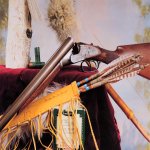
Attachments
Well, I haven't posted anything in a while and we've been lauding Chris Dawe's work, so I think I will pile on. Just got a little present in the mail from Chris yesterday.
I used to have a nice Heym 16 ga that I had lavished attention on. Nice gun and quite light for a 29" barreled 16 ga but at some point VictoryXC convinced me that he liked it better than me so I sold it to him for not enough money. That part still burns me. .
.
So I was on the lookout for another Germanic 16 ga that would fill that slot. Chris pointed me in the direction of a no name Ferlach product listed on the EE. Took a quick look, liked the pics and really liked the price, so made an offer and got it on it's way to me. When it was in my hands I was extremely impressed with the general condition. Barrels and bores were great....mirror bores and it didn't even need re-bluing. Lots of case colour left on the action. However, not that it was a surprise but it had a hideous Monte Carlo comb, a full pistol grip that was a little too tight for my taste in a hunting gun, plus a cheek piece, which I wasn't enamored with. It seemed like the actual walnut was pretty nice but the finish was a little dark. And the quality of the chequering work left a little to be desired. All problems that made it a no-brainer to send it off to Chris.
Luckily he was able to shave off the Monte Carlo and still be left with good dimensions for me. He did a good job rehab-ing the chequering and even added a horn tip to the forend. Here's the gun, I'm pretty pleased with it.
It's circa 1925. 29" barrels choked mod and mod. 2 5/8" chambers. Weighs in at 6 pounds 8 ounces. Ejectors, sideclips, cross bolt, cocking indicators.......all the hallmarks of a well made gun.






I used to have a nice Heym 16 ga that I had lavished attention on. Nice gun and quite light for a 29" barreled 16 ga but at some point VictoryXC convinced me that he liked it better than me so I sold it to him for not enough money. That part still burns me.
 .
. So I was on the lookout for another Germanic 16 ga that would fill that slot. Chris pointed me in the direction of a no name Ferlach product listed on the EE. Took a quick look, liked the pics and really liked the price, so made an offer and got it on it's way to me. When it was in my hands I was extremely impressed with the general condition. Barrels and bores were great....mirror bores and it didn't even need re-bluing. Lots of case colour left on the action. However, not that it was a surprise but it had a hideous Monte Carlo comb, a full pistol grip that was a little too tight for my taste in a hunting gun, plus a cheek piece, which I wasn't enamored with. It seemed like the actual walnut was pretty nice but the finish was a little dark. And the quality of the chequering work left a little to be desired. All problems that made it a no-brainer to send it off to Chris.
Luckily he was able to shave off the Monte Carlo and still be left with good dimensions for me. He did a good job rehab-ing the chequering and even added a horn tip to the forend. Here's the gun, I'm pretty pleased with it.
It's circa 1925. 29" barrels choked mod and mod. 2 5/8" chambers. Weighs in at 6 pounds 8 ounces. Ejectors, sideclips, cross bolt, cocking indicators.......all the hallmarks of a well made gun.






Last edited:

















































